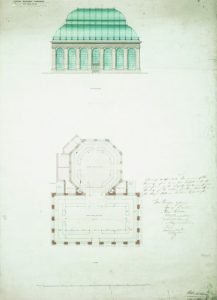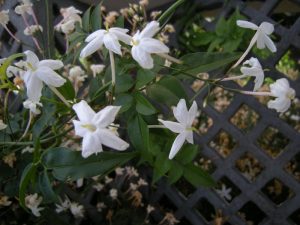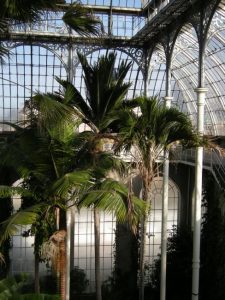Come in, look up, and appreciate the leafy canopy of the palms and the Victorian ironwork of the Temperate Palm House. April the first is the day 150 years ago that the Temperate Palm House opened its doors to the public allowing access to many newly collected plants.
It is, at 21.95 metres (72ft), the tallest traditional glasshouse in Britain. Reading the description of the building in the July 1858 edition of the Transactions of the Edinburgh Botanical Society, Professor Balfour wrote “that he believed it was the tallest palm house in the kingdom”.
A vote in 1855 of £6000 from Parliament enabled work to commence in May 1856. On completion, the total cost was £6500. The iron work for the double roof dome and the 14 supporting cast iron pillars were cast at the Shotts Foundry. The mellow sandstone blocks originate from a quarry at Bishopbriggs where the pale grey to white coloured sandstone of the Carboniferous age was laid down in a sedimentary basin.
The house was constructed slightly earlier than the Kibble Palace, another iconic botanic structure in Scotland, which has also recently undergone refurbishment of its glass frame and planting within Glasgow Botanic Garden.
Walk in from the cold and there is often a scented air to the interior. During March this was the white-flowered Jasminum polyanthum, a scandent plant from China that revels in the support allowing it to climb with ease from ground level to the height of the first balcony. A few flowers remain allowing the occasional drift of scent to be appreciated.
We do need to concentrate on the palms, the group of plants the house and its earlier (1834) tropical neighbour were named after. The tallest plant in the house is Howea forsteriana, commonly known as the Kentia palm, from Lord Howe Island. It is laden with fruit, green to red to black in colour – the raw material which provides work for islanders on Lord Howe Island, a Pacific paradise to the east of mainland Australia.
Once the whaling industry declined, the collection and export of seeds from this and H. belmoreana developed. Seed collection in the wild is a regulated process as both endemic species are categorised as vulnerable on the IUCN red data list. A specialist nursery on the island germinates and grows on for export worldwide seedlings to fulfil the constant demand for specimen plants in the interior landscape industry. It is the most popular palm sold in the garden centre trade. Kentias are ideally suited to office buildings, shopping centres and indeed as a pot plant in the home due to its tolerance of relatively low light levels.




